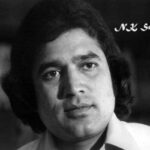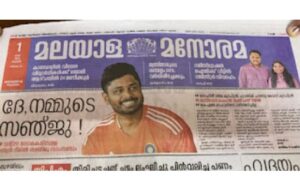We all grew up listening to Lata Mangeshkar. We loved many of her songs immensely throughout our lives, Who can ever forget her melodious voice?
 Picture Talk/By NK Sareen
Picture Talk/By NK Sareen
The eldest daughter of Master Dinanath Mangeshkar, born on 28 September 1929 in Indore, Madhya Pradesh was named Lata. She acquired the distinction of ‘the most recorded’ singer in history, singing 30,000-plus songs in several Indian and foreign languages.
After her father passed away at the young age of 41, the family of five siblings, facing a severe financial crisis, travelled to Bombay (now Mumbai) in search of work. At the tender age of 13, Lata got an acting break in a Marathi film, Pahli Manglagaur, in the year 1942, barely a few months after her father’s demise. In the same year, she also made her playback singing debut in another Marathi film called Kiti Hasal with a song ‘Naachu ya Gade Khelu,’ which, incidentally, was dropped from the film.
Four years later, in 1946, Lata got her first Hindi playback singing break in the film Aap Ke Sewa Main under the music direction of Vasant Joglekar. It took another two years for Lata to get noticed in singer/composer Ghulam Haider’s film Majboor. Her big break came in 1949 with her song ‘Aayega Aanewala’ for the film Mahal, directed and produced by Kamal Amrohi, with Ashok Kumar and Madhubala in the lead roles, and music by Khemchand Prakash. The song became a super hit. The film Mahal became a cult classic and money spinner as well. Mahal launched two careers – the playback singing career of Lata Mangeshkar and the acting career of Madhubala. Both achieved great glory and success in their respective careers.
Lata’s other superhit songs of the year 1949 were ‘Uthaye Ja Unke Sitam’ from the film Andaz and ‘Jiya Bekarar Hai’ from Raj Kapoor’s film Barsaat. The three songs catapulted her to such heights of superstardom that she never had to look back.

We all grew up listening to her. We loved many of her songs immensely throughout our lives. This picture of Lata Mangeshkar was taken in a sound recording studio in Tardev, if I remember correctly, quite early in my career, I think. For this picture, I clearly remember I had accompanied my friend R M Kumtakar, an assistant editor and a very well-respected journalist photographer working for the film weekly Screen, brought out by the Indian Express group of newspapers from Express Towers, located at Nariman Point.
I was very lucky to have met Kumtakar for two reasons: he was a well-known and very respected by all the stalwarts of the industry. He was also a photographer. Though he very rarely got out to cover the shoots of the films, whenever and wherever he took me along to introduce me to someone, he always praised me very highly and introduced me as “a great photographer”.
That day, Lata Mangeshkar was recording a song inside the recording theater at the time when we arrived. This picture was taken with available light in the studio. My friend couldn’t introduce me to her or to the music duo Laxmikant and Pyarelal, both of whom were busy rehearsing and conducting the music inside that small room. It’s because of R M Kumtaker that I also had very good pictures of Lata’s sister, Asha Bhosle, who had, in fact, invited me to her home and asked me to do a cover picture for her coming album. I did try to meet Lata Didi during my visit to Asha’s residence, who lived in the adjacent flat but was told she was on a foreign tour those days.
In her career spanning close to seven decades, Lata worked with most top music directors, singers, and lyric writers of the time. One of her favourites was music director Madan Mohan, for whom she sang many ghazals. Though Lata had worked with most top directors, she did get involved in a few controversies with Mohammad Rafi, and music director S D Burman.
O P Nayyar was the only top music director who never worked with Lata, preferring her sister Asha Bhosle to work with. There used to be several rumours, some false, some true, of her fights, manipulating nature, influencing and controlling the music industry to her advantage, not allowing the younger lot of singers to come up and so on.
Lata collected every award worth mentioning, won billions of fans not only in India but all across the globe, became a Rajya Sabha member, remained a spinster all her life, and led a simple life at her Prabhu Kunj residence on Pedder Road in Mumbai. She was rightly called the ‘Nightingale of India’, a living legend, but most lovingly she was called ‘Lata Didi’ by one and all.
The worldly journey of Lata Didi, the legend, which started on September 28, 1929, concluded on February 6, 2022, just seven years short of a century. A pall of gloom fell all over the country leaving billions of her fans teary eyed. Legends never die, and the legend of Lata Mangeshkar will always live and remain deep in our hearts and minds. How aptly she herself had sung that song written by Gulzar in his 1977 film, ‘Kinara’: Naam gum jaayega chehra ye badal jayega, meri awaaz hi meri pehchan hai jo yaad rahe.
Who can forget that melodious voice, ever?
In this column, ‘Picture Talk’, veteran photo journalist NK Sareen, a former Photo Editor at Expanse International and a writer, shines light on some of the pictures of personalities he has clicked over the years, with a touch of nostalgia. The views expressed here are the author’s own and The News Porter bears no responsibility for the same.












More Stories
When Rajesh Khanna left the shoot mid-way, told scribe, ‘I’m going for a screw’
Of the Northern Lights and an Adventure with Huskies in Swedish Lapland!
1st April question: Is April Fool’s Day indeed a fool’s day?